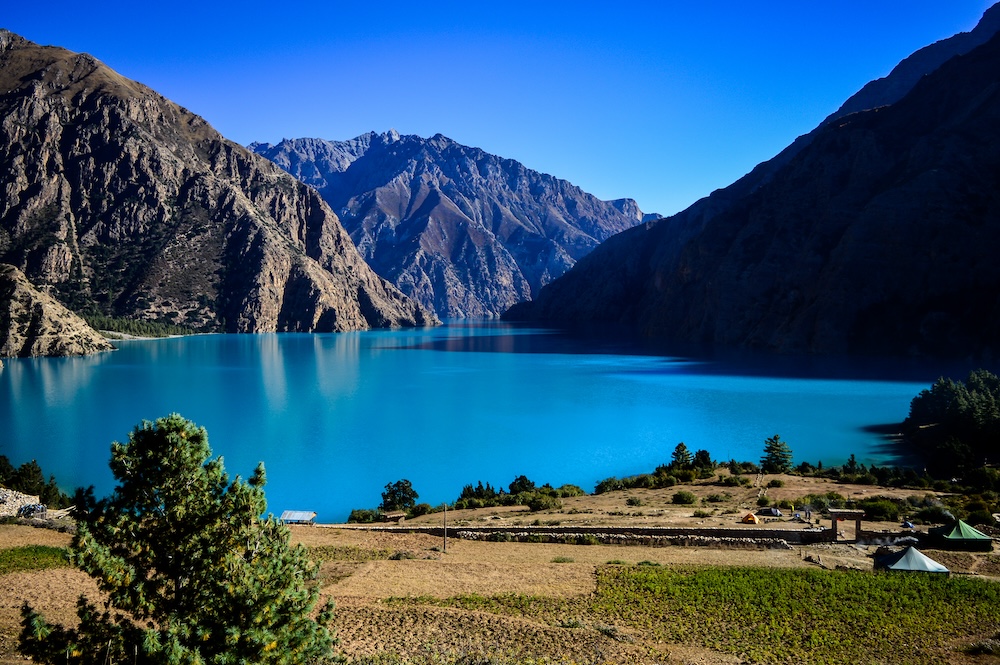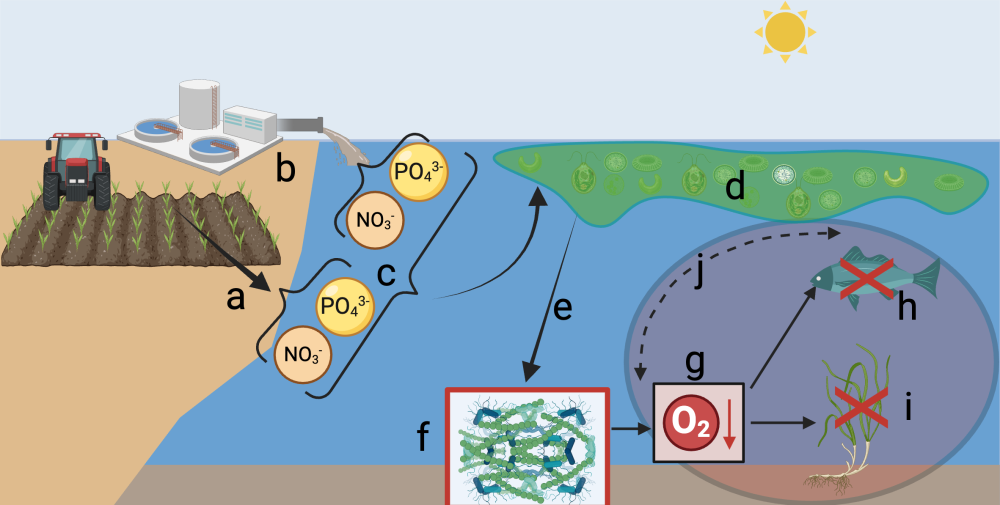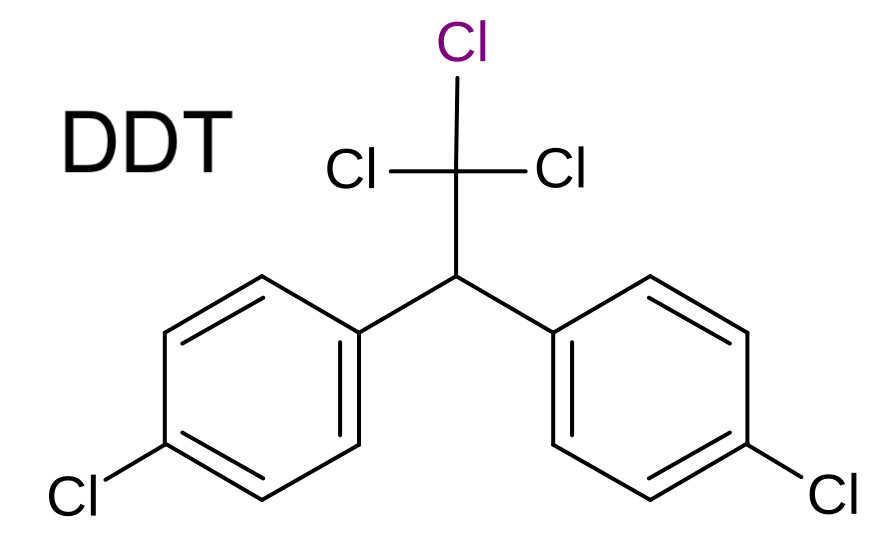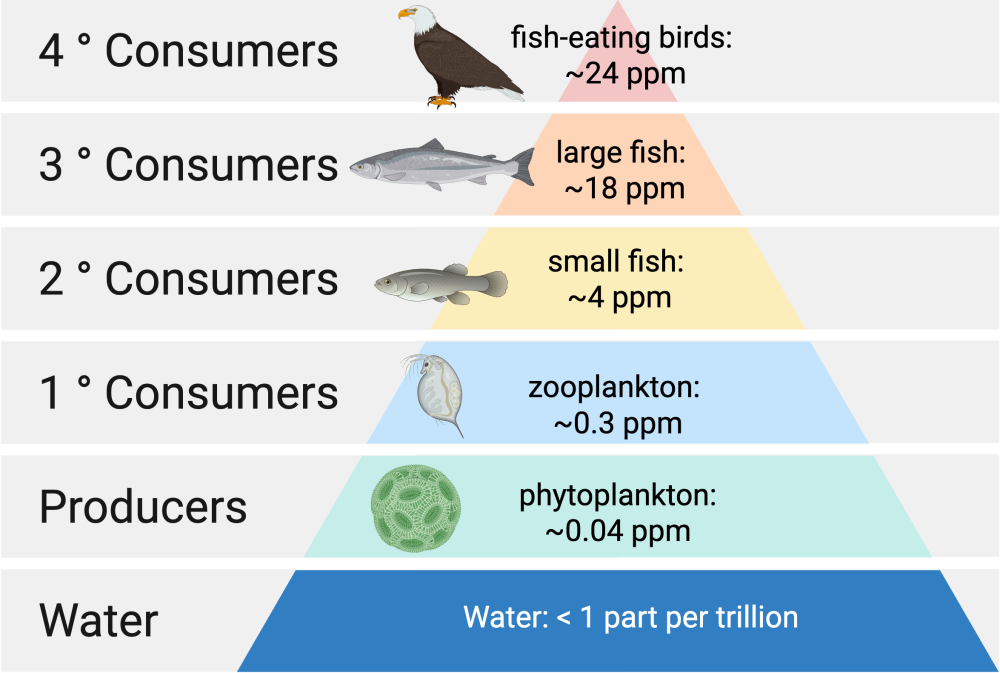1. Eutrophication

Bodies of freshwater — including lakes, rivers, and streams — are normally oligotrophic. That means they have low levels of nutrients, such as nitrogen and phosphorus. As a result, oligotrophic waters are typically clear, have high oxygen levels, and support diverse, balanced aquatic communities.
The use of fertilizers in agriculture, sewage discharge, and runoff from urban areas can add excess nutrients to freshwater and marine ecosystems. This nutrient overload causes a process called eutrophication.
Here’s how eutrophication works.

Runoff from farms (a) and discharge from sewage treatment plants (b) add excess nitrates (NO3) and phosphates (PO43-) to freshwater ecosystems. This flux of nitrates and phosphates is represented as “c” in the diagram.
These nutrients remove a limiting factor on the growth of algae, creating an algae bloom (d). While algae produce oxygen through photosynthesis during the day, they also perform aerobic respiration. At nighttime, when photosynthesis ceases, this lowers the level of dissolved oxygen in the water, creating a stressful (and even deadly) situation for oxygen-requiring animals and plants.
When the algae die (e), their remains are consumed by bacterial decomposers (f). Aerobic respiration by these decomposers causes a further decrease in dissolved oxygen levels (g). This kills fish and other aquatic animals. Aquatic plants (i) are also killed by the lack of oxygen, as well as by the obstruction of light caused by the algae bloom. The result is a “dead zone” (j) in the lake or pond.
The term eutrophic can be confusing. It means “well-nourished,” which you’d think would be a good thing. However, as you’ve seen, the excess nitrates and phosphates create an ecosystem with very little biodiversity (since nothing besides algae and their decomposers can survive). Oligotrophic freshwater ecosystems, with less nutrient input, have higher biodiversity, stability, and resilience.
Eutrophication can happen naturally as lakes and ponds fill with organic debris over time, a process that’s part of ecological succession. When eutrophication is caused by human inputs of nitrates and phosphates, it’s called “cultural eutrophication:” eutrophication caused by human culture, particularly agriculture.

Note that these dead zones caused by eutrophication can be enormous. Every summer, nutrient inputs from farms in the Mississippi river watershed wash into the Gulf of Mexico, causing an algae bloom and dead zone that can be as large as the entire state of New Jersey. You can learn more and watch a video about this dead zone on the US National Oceanic and Atmospheric Administration’s website.
2. Eutrophication Flashcards
[qdeck bold_text=”false” random=”true” style=”min-height: 400px !important;” qrecord_id=”sciencemusicvideosmeister1961-Eutrophication Flashcards”]
[h] Eutrophication Flashcards
[i] Biohaiku
Eutrophication
Phosphate and nitrate inputs
Deadly algae bloom
[start]
[q] What are the characteristics of oligotrophic bodies of water?
[a] Oligotrophic aquatic ecosystems are low in nutrients like nitrogen and phosphorus. As a result, they’re clear, high in oxygen, and support diverse, balanced ecosystems.
[q] What does “eutrophic” literally mean?
[a] “Eutrophic” comes from Greek and means “well-nourished.” In ecology, it refers to water bodies with high nutrient levels, especially nitrates and phosphates.
[q] What human activities contribute to eutrophication?
[a] Fertilizer runoff from farms, sewage discharge, and urban runoff add nitrates (NO₃⁻) and phosphates (PO₄³⁻) to aquatic ecosystems.
[q] Which two nutrients are primarily responsible for eutrophication?
[a] Nitrates (NO₃⁻) and phosphates (PO₄³⁻).
[q] What causes an algal bloom in a eutrophic system?
[a] Excess nitrates and phosphates remove the normal nutrient limits on algal growth, causing algae to grow rapidly.
[q] How does an algal bloom lower oxygen levels?
[a] At night, algae respire and consume oxygen. When they die, decomposers use oxygen to break down the algae, further reducing oxygen levels.
[q] Why does eutrophication lead to fish kills?
[a] Decomposers use up dissolved oxygen during the breakdown of dead algae. Low oxygen suffocates fish and other aquatic life.
[q] What happens to aquatic plants during eutrophication?
[a] They die from a lack of oxygen and because the algal bloom blocks sunlight.
[q] In relation to eutrophication, what is a “dead zone”?
[a] A dead-zone (“j” bel0w), in the context of eutrophication, is a region in a lake, pond, or ocean where oxygen levels are so low that most aquatic organisms cannot survive.
[q] What’s the difference between natural and cultural eutrophication?
[a] Natural eutrophication occurs slowly through ecological succession. Cultural eutrophication is caused by human inputs of nutrients and happens rapidly.
[q] How is eutrophication an example of human impact on ecosystems?
[a] It shows how human changes to nutrient cycles (especially nitrogen and phosphorus) can reduce biodiversity and destabilize ecosystems.
[q] In the diagram below, what does label “a” represent?
[a] Letter “a” represents runoff from agricultural fields, which contains excess nitrates (NO₃⁻) and phosphates (PO₄³⁻) from fertilizers.
[q] In the diagram below, what does label “b” represent?
[a] Label “b” shows sewage discharge from a treatment plant, which contributes nitrates and phosphates to the water.
[q] What do the arrows and nutrients labeled “c” represent?
[a] Label “c” represents the movement of nitrates (NO₃⁻) and phosphates (PO₄³⁻) into the aquatic system. These nutrients remove natural growth limits on algae.
[q] In the diagram below, what does label “d” represent?
[a] Label “d” shows an algal bloom — a dense growth of algae caused by nutrient enrichment.
[q] In the diagram below, what does label “e” represent?
[a] Label “e” shows the death and sinking of algae, which become organic debris in the water (and food for the decomposers at “f”).
[q] What does label “f” show in the diagram?
[a] Label “f” represents bacterial decomposers that break down dead algae using aerobic respiration.
[q] In the diagram below, what is shown at label “g”?
[a] Label “g” indicates a drop in oxygen levels due to nighttime aerobic respiration by algae in the algae bloom, and aerobic respiration by decomposers.
[q] What is happening to the fish at label “h”?
[a] Label “h” shows fish dying because they can’t survive in the low-oxygen environment created by eutrophication.
[q] Why are aquatic plants dying at label “i”?
[a] Label “i” shows aquatic plants dying from both low oxygen levels and lack of sunlight due to the algae bloom.
[q] What ecological condition is represented by label “j”?
[a] Label “j” represents a “dead zone” — an area of low biodiversity caused by low oxygen conditions where most aquatic life can’t survive.
[/qdeck]
3. Eutrophication Quiz
[qwiz qrecord_id=”sciencemusicvideosMeister1961-Eutrophication Quiz”]
[h] Eutrophication Quiz
[i]
[q] In the diagram below, what letter indicates runoff from agricultural fields, which contains excess nitrates and phosphates?
[textentry single_char=”true”]
[c]IG E=[Qq]
[f]IEdvb2Qh[Qq]
[c]ICo=[Qq]
[f]IE5vLiBMb29rIGZvciB0aGUgcGFydCBvZiB0aGUgZGlhZ3JhbSB0aGF0IHNob3dzIGEgZmFybSBuZWFyIGEgZmllbGQg4oCUIHdoZXJlIGZlcnRpbGl6ZXIgcnVub2ZmIHdvdWxkIGVudGVyIHRoZSBzeXN0ZW0u[Qq]
[q] In the diagram below, the nitrate and phosphate at letter “a” results from runoff of [hangman] that farmers add to their fields in order to improve agricultural productivity.
[c]IGZlcnRpbGl6ZXI=[Qq]
[f]IEV4Y2VsbGVudCE=[Qq]
[q] In the diagram below, what letter indicates sewage discharge into the water?
[textentry single_char=”true”]
[c]IG I=[Qq]
[f]IEdvb2Qh[Qq]
[c]ICo=[Qq]
[f]IE5vLiBMb29rIGZvciB0aGUgc3RydWN0dXJlIHJlcHJlc2VudGluZyBhIHNld2FnZSB0cmVhdG1lbnQgcGxhbnQuIFdoaWNoIGxldHRlciBpcyBhc3NvY2lhdGVkIHdpdGggdGhhdD8=[Qq]
[q] Algae blooms appear when lakes or ponds experience [hangman]
[c]IGV1dHJvcGhpY2F0aW9u[Qq]
[f]IEdvb2Qh[Qq]
[q] In the diagram below, what letter represents an algal bloom caused by excess nutrient input?
[textentry single_char=”true”]
[c]IG Q=[Qq]
[f]IEdvb2Qh[Qq]
[c]ICo=[Qq]
[f]IE5vLiBMb29rIGZvciB3aGVyZSB5b3Ugc2VlIGEgc3VkZGVuIGluY3JlYXNlIGluIGdyZWVuLWNvbG9yZWQgYWxnYWwgZ3Jvd3RoLg==[Qq]
[q] In the diagram below, what letter shows bacterial decomposers that use up oxygen?
[textentry single_char=”true”]
[c]IG Y=[Qq]
[f]IEV4Y2VsbGVudCE=[Qq]
[c]ICo=[Qq]
[f]IE5vLiBMb29rIGZvciBvcmdhbmlzbXMgdGhhdCAmIzgyMjA7cmVjZWl2ZSYjODIyMTsgZGVhZCBhbGdhZSwgYW5kIHRoZW4gY29uc3VtZSB0aGVtIHVzaW5nIGFlcm9iaWMgcmVzcGlyYXRpb24u[Qq]
[q] In the diagram below, what letter shows oxygen depletion caused by decomposers?
[textentry single_char=”true”]
[c]IG c=[Qq]
[f]IENvcnJlY3Qh[Qq]
[c]ICo=[Qq]
[f]IE5vLiBMb29rIG5lYXIgdGhlIGRlY29tcG9zZXJzLiBXaGVyZSBtaWdodCBveHlnZW4gYmUgZGlzYXBwZWFyaW5nPw==[Qq]
[q] What term describes the part of a lake or pond that has very low biodiversity due to oxygen loss and algal overgrowth?
[hangman]
[c]IGRlYWQgem9uZQ==[Qq]
[f]IEdvb2Qh[Qq]
[q] At letter “i’ we see aquatic plants dying from low levels of the gas [hangman], as well as low levels of [hangman], which is blocked by the algae bloom at “d”
[c]IG94eWdlbg==[Qq]
[f]IEdyZWF0IQ==[Qq]
[c]IGxpZ2h0[Qq]
[f]IEdvb2Qh[Qq]
[q] What kind of freshwater ecosystem has low nutrient levels and high biodiversity?
[hangman]
[c]IG9saWdvdHJvcGhpYw==[Qq]
[f]IEdvb2Qh[Qq]
[q] What Greek-derived word means “well nourished” and describes a nutrient-rich (but diversity-poor) aquatic system?
[hangman]
[c]IGV1dHJvcGhpYw==[Qq]
[f]IEdyZWF0IQ==[Qq]
[q] Two chemical ions most often cause eutrophication. The first is [hangman], which almost never becomes a gas. The second is [hangman], which appears in ecosystems when bacteria oxidize ammonia (NH4).
[c]IHBob3NwaGF0ZQ==[Qq]
[f]IENvcnJlY3Qh[Qq]
[c]IG5pdHJhdGU=[Qq]
[f]IEV4Y2VsbGVudCE=
Cg==[Qq]
[q multiple_choice=”true”]What is the best description of “cultural eutrophication”?
[c]TnV0cmllbnQgYnVpbGR1cCBpbiBsYWtlcyBmcm9tIHdlYXRoZXJpbmcsIHNlZGltZW50YXRpb24sIGFuZCBvdGhlciBwcm9jZXNzZXM=[Qq]
[f]Tm8uIFRoaXMgZGVzY3JpYmVzIA==bmF0dXJhbA==IG51dHJpZW50IGFjY3VtdWxhdGlvbiwgbm90IHRoZSBraW5kIGFjY2VsZXJhdGVkIGJ5IGh1bWFuIGFjdGl2aXR5Lg==[Qq]
[c]UmVkdWNlZCBudXRyaWVudCBsZXZlbHMgZHVlIHRvIGNvbnNlcnZhdGlvbiBlZmZvcnRz[Qq]
[f]Tm8uIEN1bHR1cmFsIGV1dHJvcGhpY2F0aW9uIGludm9sdmVzIGFuIGluY3JlYXNlLCBub3QgYSBkZWNyZWFzZSwgaW4gbnV0cmllbnQgbGV2ZWxzLg==[Qq]
[c]SHVtYW4tY2F1c2VkIGluY3JlYXNlcyBvZiBu dXRyaWVudHMgaW50byB3YXRlciBzeXN0ZW1z[Qq]
[f]Q29ycmVjdCEgQ3VsdHVyYWwgZXV0cm9waGljYXRpb24gaXMgY2F1c2VkIGJ5IGh1bWFuIGFjdGlvbnMgc3VjaCBhcyBmZXJ0aWxpemVyIHJ1bm9mZiBhbmQgc2V3YWdlIGRpc2NoYXJnZS4=[Qq]
[c]SW52YXNpdmUgc3BlY2llcyBjYXVzaW5nIGVjb2xvZ2ljYWwgZGlzcnVwdGlvbiBpbiBhcXVhdGljIGVjb3N5c3RlbXM=[Qq]
[f]Tm8uIFdoaWxlIGludmFzaXZlIHNwZWNpZXMgY2FuIGRpc3J1cHQgZWNvc3lzdGVtcywgdGhhdOKAmXMgbm90IHdoYXQg4oCcY3VsdHVyYWwgZXV0cm9waGljYXRpb27igJ0gcmVmZXJzIHRvLg==
[q multiple_choice=”true”]Which process contributes most directly to the formation of a “dead zone” in an aquatic system?
[c]IEFsZ2FlIGFic29yYmluZyBleGNlc3MgbnV0cmllbnRz[Qq]
[f]Tm8uIFdoaWxlIG51dHJpZW50IGFic29ycHRpb24gYnkgYWxnYWUgdHJpZ2dlcnMgdGhlIGJsb29tLCBpdCYjODIxNztzIG5vdCB0aGUgbWFpbiBjYXVzZSBvZiB0aGUgZGVhZCB6b25lLg==[Qq]
[c]IEJhY3RlcmlhIGNvbnN1bWluZyBveHln ZW4gZHVyaW5nIGRlY29tcG9zaXRpb24=[Qq]
[f]Q29ycmVjdCEgQXMgYmFjdGVyaWEgZGVjb21wb3NlIGRlYWQgYWxnYWUsIHRoZXkgdXNlIHVwIGRpc3NvbHZlZCBveHlnZW4sIGxlYWRpbmcgdG8gaHlwb3hpYyBjb25kaXRpb25zIG9yICYjODIyMDtkZWFkIHpvbmVzLiYjODIyMTs=[Qq]
[c]IE9yZ2FuaWMgbWF0ZXJpYWwgc2V0dGxpbmcgdG8gdGhlIGxha2UgYm90dG9t[Qq]
[f]Tm8uIFNlZGltZW50YXRpb24gb2NjdXJzLCBidXQgaXTigJlzIHRoZSBveHlnZW4gY29uc3VtcHRpb24gYnkgZGVjb21wb3NlcnMgdGhhdCBkaXJlY3RseSBjYXVzZXMgZGVhZCB6b25lcy4=[Qq]
[c]IEFxdWF0aWMgcGxhbnRzIGFic29yYmluZyBuaXRyYXRlcyBhbmQgcGhvc3BoYXRlcw==[Qq]
[f]Tm8uIFBsYW50cyB1c2UgbnV0cmllbnRzLCBidXQgdGhleSBkb27igJl0IGRlcGxldGUgb3h5Z2VuIGluIHRoZSB3YXkgZGVjb21wb3NpbmcgYmFjdGVyaWEgZG8u
[q multiple_choice=”true”]In a river receiving inputs of domestic sewage rich in organic waste, the most likely outcome is
[c]aW5jcmVhc2VkIGRpdmVyc2l0eSBvZiBhcXVhdGljIG9yZ2FuaXNtcw==[Qq]
[f]Tm8uIFdoaWxlIHNvbWUgb3JnYW5pc21zIG1heSBiZW5lZml0LCB0aGUgb3h5Z2VuIGRlcGxldGlvbiB0aGF0IGZvbGxvd3Mgb2Z0ZW4gcmVkdWNlcyBiaW9kaXZlcnNpdHkuIFN0dWR5IHRoZSBkaWFncmFtIGJlbG93IGFuZCB0cnkgYWdhaW4=
[c]YW4gaW5jcmVhc2VkIHByb2R1Y3Rpb24gb2YgZmlzaCBiZWNhdXNlIG9mIGluY3JlYXNlcyBpbiB0aGUgc3lzdGVtJiM4MjE3O3MgcHJvZHVjZXJz[Qq]
[f]Tm8uIEZpc2ggbWF5IGluaXRpYWxseSBiZW5lZml0LCBidXQgb3h5Z2VuIGRlcGxldGlvbiBmcm9tIGRlY29tcG9zaXRpb24gd2lsbCBsaWtlbHkgY2F1c2UgZmlzaCBraWxscy4gU3R1ZHkgdGhlIGRpYWdyYW0gYmVsb3cgYW5kIHRyeSBhZ2Fpbg==
[c]ZGVhdGggb2YgZmlzaCBkdWUg dG8gbGFjayBvZiBveHlnZW4=[Qq]
[f]Q29ycmVjdCEgRGVjb21wb3NpdGlvbiBvZiBvcmdhbmljIG1hdHRlciBieSBiYWN0ZXJpYSBjb25zdW1lcyBveHlnZW4sIGxlYWRpbmcgdG8gaHlwb3hpYyBjb25kaXRpb25zIHRoYXQga2lsbCBmaXNoLg==[Qq]
[c]b3Zlcmdyb3d0aCBvZiBhbGdhZSB0aGF0IHdpbGwgY2F1c2UgdGhlIHJpdmVyIHRvIGRyeSBvdXQu[Qq]
[f]Tm8uIEFsZ2FsIG92ZXJncm93dGggY2FuIGJsb2NrIGxpZ2h0IGFuZCBkZXBsZXRlIG94eWdlbiwgYnV0IGl0IHdvbuKAmXQgY2F1c2UgdGhlIHJpdmVyIHRvIGRyeSBvdXQuIFN0dWR5IHRoZSBkaWFncmFtIGJlbG93IGFuZCB0cnkgYWdhaW4=
[/qwiz]
4. Biomagnification
Like eutrophication, biomagnification is a process by which human contamination of the environment leads to ecosystem disruption. To see how it works, complete the interactive reading below.
[qwiz qrecord_id=”sciencemusicvideosMeister1961-Biomagnification Interactive Reading”]
[h] Biomagnification, interactive reading
[i] Biohaiku:
Mighty bald eagle:
Biomagnification
Almost wiped it out
[q multiple_choice=”true”] Meet DDT (dichlorodiphenyltrichloroethane). DDT is an insecticide that was developed in the 1940s, and then widely released into the environment during the 1950s and 1960s.
Based on its structural formula, you can predict that DDT is
[c]IGh5ZHJvcGhpbGlj[Qq]
[f]IE5vLiBXaGlsZSB5b3UgbWlnaHQgaGF2ZSBiZWVuIGNvbmZ1c2VkIGJ5IHRoZSBjaGxvcmluZSBhdG9tcywgdGhlIGtleSB0aGluZyB0byBub3RlIGFyZSB0aGUgY2FyYm9uIHJpbmdzLCBhbmQgdGhlIGxhY2sgb2YgYW55IG9mIHRoZSBmdW5jdGlvbmFsIGdyb3VwcyB0aGF0IHdvdWxkIGZvcm0gaHlkcm9nZW4gYm9uZHMgd2l0aCB3YXRlciAoc3VjaCBhcyBoeWRyb3h5bCwgY2FyYm9ueWwsIGV0Yy4p[Qq]
[c]IGh5ZHJv cGhvYmlj[Qq]
[f]IEV4Y2VsbGVudC4gQmFzZWQgb24gaXRzIHN0cnVjdHVyZSwgRERUIGlzIGh5ZHJvcGhvYmljLg==[Qq]
[q] Because DDT is hydrophobic, it won’t dissolve in [hangman]. As a result, once it gets into an organism’s body, it tends to stay there, and won’t get excreted from the body through urine (or similar excretions).
[c]IHdhdGVy[Qq]
[f]IEdvb2Qh[Qq]
[q labels=”top”]Based on what you’ve learned about DDT, and what you know about ecosystem structure, label the diagram below. “Units/gram of tissue” refers to units of DDT.
[f*] Excellent!
[fx] No, that’s not correct.
[l]1° consumer
[fx] No. Please try again.
[f*] Good!
[l]2° consumer
[fx] No, that’s not correct. Please try again.
[f*] Correct!
[l]3° consumer
[fx] No, that’s not correct. Please try again.
[f*] Great!
[l]5
[fx] No, that’s not correct. Please try again.
[f*] Good!
[l]11
[fx] No, that’s not correct. Please try again.
[f*] Excellent!
[l]18
[fx] No. Please try again.
[f*] Excellent!
[l]43
[fx] No. Please try again.
[f*] Excellent!
[q labels = “top”]Based on what you’ve learned, fill in the blanks below:
____________________ is the process by which certain ________ become more concentrated as they move up through the _________ levels that make up an ecosystem. The substances that become biomagnified are usually _____-soluble (or, to review some biochemistry, _______________ or nonpolar). Because these substances cannot be easily broken down or excreted in urine, sweat, or other secretions, they ______________ in the bodies of organisms. When a predator eats many contaminated _______, the toxin concentration increases to a higher level in the predator’s body than it was in the prey’s body. As a result, top predators like bald eagles or orcas can carry dangerously high levels of toxins, even if the original environmental ________________ was very low.
[l]accumulate
[fx] No. Please try again.
[f*] Great!
[l]biomagnification
[fx] No, that’s not correct. Please try again.
[f*] Correct!
[l]concentration
[fx] No, that’s not correct. Please try again.
[f*] Correct!
[l]fat
[fx] No, that’s not correct. Please try again.
[f*] Correct!
[l]prey
[fx] No. Please try again.
[f*] Good!
[l]toxins
[fx] No, that’s not correct. Please try again.
[f*] Correct!
[l]trophic
[fx] No, that’s not correct. Please try again.
[f*] Correct!
[l]hydrophobic
[fx] No. Please try again.
[f*] Great!
[/qwiz]
5. Bald Eagles and DDT: A biomagnification case-study
Here’s how biomagnification nearly wiped out Bald Eagles in the lower 48 states.
Bald eagles are predators, preying on birds and small mammals. They also scavenge carrion (dead carcasses of mammals, birds, or fish).

As you read above, DDT (dichlorodiphenyltrichloroethane) is an insecticide that was first used during World War II (during the 1940s) and then widely used in agriculture for insect-control during the 1940s, 1950s, and 1960s.

During the 1950s and 1960s, when DDT was widely applied to farm fields, it made its way to waterways through two routes. Some of the DDT was sprayed onto fields from airplanes, and drifted over into adjacent waterways. In addition, some DDT attached itself to soil particles, which ran off into streams, rivers, lakes and oceans.
The DDT in the water was at low concentrations: as low as 1 part DDT/trillion parts of water. A very small amount of DDT was taken up by phytoplankton: single celled-producers that form the basis of aquatic food chains.
These phytoplankton were consumed by the next trophic level: zooplankton (“animal plankton”). In the bodies of these zooplankton, hydrophobic DDT persisted in body tissues, and rose in concentration. This was repeated at every trophic level, until the concentration of DDT in the body tissues of bald eagles — a top predator —was thousands of times higher than it had been in the phytoplankton, and millions of times higher than it had been in the water.
The most notable effect of DDT on bald eagles involved reproduction. Once in the body, DDT and its byproducts acted as a noncompetitive inhibitor of enzymes that played a key role in eggshell formation. The result was “eggshell thinning syndrome,” which caused many eggs to break during incubation or before hatching.
DDT-related declines in populations of eagles and other birds of prey were noted as early as 1947. By 1963, only 417 nesting pairs of Bald Eagles survived in the United States. This decline, along with other pesticide-related harms noted in the groundbreaking work of marine biologist Rachel Carson in her book Silent Spring, led to the banning of DDT in the United States in 1972.
By 1995 (23 years after DDT’s ban), Bald Eagle populations had recovered to the point where the bird’s protection status could be reclassified from “endangered” to “threatened.” In 2007, Bald Eagles had recovered enough to be entirely removed from the U.S. Endangered Species List.
6. Biomagnification affects many top-level predators, including humans
Many pollutants biomagnify in the environment. These include:
- Certain types of pesticides. Like DDT, almost all of these pesticides are nonpolar and contain chlorine as part of their structure.
- PCBs. PCBs (polychlorinated biphenyls) were once widely used in electrical equipment, coolants, and plastics. Like DDT, they’re fat soluble and can accumulate in an organism’s body. They cause hormonal disruption, immune system damage, and reproductive problems in wildlife and humans. They were banned in the U.S. in 1979, but still persist in the environment.
- Mercury. Mercury is an element that gets released into the environment though activities like coal burning and gold mining. Once in the environment, bacteria incorporate mercury into a variety of metabolic pathways that result in formation of lipid-soluble methyl mercury, which can accumulate within organisms and biomagnify within ecosystems. Mercury exposure can cause nerve damage and reproductive harm in predators like otters, loons, and people.
Species that have suffered from biomagnification include
🦅 Birds of Prey (similar to the bald eagle)
Peregrine falcons, ospreys, and brown pelicans all suffered massive declines due to DDT. Brown pelicans in particular were nearly wiped out from parts of the Gulf Coast.
🐟 Fish-Eating Mammals and Birds
River otters, mink, and loons have been affected by mercury and PCBs.
🐋 Marine Mammals
Orcas (killer whales) and polar bears are among the most contaminated animals on Earth with PCBs and DDT.
🐢 Sea Turtles and Other Reptiles
Some sea turtles and alligators have shown endocrine disruption (e.g., altered hormone levels, skewed sex ratios) due to exposure to pesticides and PCBs.
🧍 Humans
Indigenous Arctic populations, who rely on marine mammals for food, have been found to carry high levels of POPs (persistent organic pollutants) like DDT and PCBs in their tissues. Fish-consuming populations around the world are at risk of mercury poisoning, especially pregnant women and children.
7. Biomagnification Flashcards
[qdeck bold_text=”false” qrecord_id=”sciencemusicvideosMeister1961-Biomagnification Flashcards”]
[h]Biomagnification Flashcards
[i]
[q]What is biomagnification?
[a]Biomagnification is the process by which certain toxins become more concentrated as they move up through the trophic levels in a food chain.
[q]What types of substances tend to biomagnify?
[a]Fat-soluble (hydrophobic or nonpolar) substances that cannot be easily broken down or excreted, such as DDT, PCBs, and mercury.
[q]Why do toxins like DDT become more concentrated in top predators?
[a]Because these predators eat many contaminated prey, and the toxins accumulate in their bodies over time.
[q]Why doesn’t DDT dissolve in water?
[a]DDT is hydrophobic because of its carbon ring structure and lack of polar functional groups like hydroxyl or amino groups.
[q]How did DDT get into aquatic ecosystems?
[a]DDT entered water through
- aerial spraying with some spray drifting into water and
- by binding to soil particles that were carried into streams and lakes by runoff.
[q]What role did phytoplankton play in DDT biomagnification?
[a]Phytoplankton absorbed small amounts of DDT from the water, beginning the accumulation of the toxin in the food chain.
[q]What happened as zooplankton and fish ate the contaminated phytoplankton?
[a]DDT became more concentrated at each trophic level, reaching very high levels in top predators like bald eagles.
[q]How did DDT harm bald eagle reproduction?
[a]DDT and its byproducts inhibited enzymes involved in eggshell formation, causing eggshell thinning and reproductive failure.
[q]What happened to the bald eagle’s conservation status after DDT was banned in the late 1970s?
[a]After DDT was banned, bald eagles were reclassified from “endangered” to “threatened” in 1995, and removed from the Endangered Species List in 2007.
[q]What are PCBs, and why are they dangerous?
[a]PCBs are synthetic industrial chemicals that are fat-soluble and persistent in the environment. They cause hormonal disruption, immune system damage, and reproductive problems.
[q]What is mercury, and why is it dangerous when released into the environment?
[a]Mercury an element that can be incorporated into an organic form – methylmercury– by bacteria. Methylmercury is toxic and fat-soluble, enabling it to accumulate in aquatic food chains where it causes neurological and reproductive damage.
[q]How has biomagnification affected humans?
[a]Indigenous Arctic populations and other fish-consuming groups carry high levels of toxins like DDT, PCBs, and methylmercury, which can cause reproductive and neurological harm.
[/qdeck]
8. Biomagnification Quiz
[qwiz qrecord_id=”sciencemusicvideosMeister1961-Biomagnification Quiz”]
[h]Biomagnification Quiz
[i]
[q multiple_choice=”true”]What is biomagnification?
[c]VGhlIHByb2Nlc3MgYnkgd2hpY2ggdG94aW5zIGFyZSBkZXN0cm95ZWQgYnkgb3JnYW5pc21zIGFzIHRoZXkgbW92ZSB1cCB0aGUgZm9vZCBjaGFpbi4=[Qq]
[f]Tm8uIEJpb21hZ25pZmljYXRpb24gcmVmZXJzIHRvIHRveGlucyBiZWNvbWluZyBtb3JlIGNvbmNlbnRyYXRlZCwgbm90IGRlc3Ryb3llZC4=[Qq]
[c]VGhlIHByb2Nlc3MgYnkgd2hpY2ggdG94aW5zIGFyZSBkaWx1dGVkIGFzIHRoZXkgbW92ZSB0aHJvdWdoIHRoZSBlY29zeXN0ZW0u[Qq]
[f]Tm8uIEJpb21hZ25pZmljYXRpb24gaXMgYWJvdXQgaW5jcmVhc2luZywgbm90IGRlY3JlYXNpbmcsIGNvbmNlbnRyYXRpb24u[Qq]
[c]QW4gaW5jcmVhc2UgaW4gdG94aW4gY29uY2VudHJh dGlvbiBhdCBoaWdoZXIgdHJvcGhpYyBsZXZlbHMu[Qq]
[f]TmljZSB3b3JrISBCaW9tYWduaWZpY2F0aW9uIGlzIHRoZSBpbmNyZWFzaW5nIGNvbmNlbnRyYXRpb24gb2YgdG94aW5zIGluIHRvcC1sZXZlbCBwcmVkYXRvcnMu[Qq]
[c]VGhlIGFjY3VtdWxhdGlvbiBvZiBmYXQtc29sdWJsZSBudXRyaWVudHMgaW4gcHJvZHVjZXJzLg==[Qq]
[f]Tm8uIEJpb21hZ25pZmljYXRpb24gaW52b2x2ZXMgZmF0LXNvbHVibGUgdG94aW5zLCBub3QgbnV0cmllbnRzLg==
[q multiple_choice=”true”]Which substances are most likely to biomagnify?
[c]V2F0ZXItc29sdWJsZSBwb2xhciBhbmQgaW9uaWMgY29tcG91bmRzIHRoYXQgY2FuIGJlIGRpc3NvbHZlZCBpbiB1cmluZSBhbmQgZXhjcmV0ZWQgZWFzaWx5Lg==[Qq]
[f]Tm8uIFN1YnN0YW5jZXMgdGhhdCBiaW9tYWduaWZ5IGFyZSBub3Qgd2F0ZXItc29sdWJsZSBhbmQgYXJlIGRpZmZpY3VsdCB0byBleGNyZXRlLg==[Qq]
[c]RmF0LXNvbHVibGUgKGh5ZHJvcGhvYmljIG9yIG5vbnBvbGFyKSBz dWJzdGFuY2VzIGxpa2UgRERULCBQQ0JzLCBhbmQgbWVyY3VyeS4=[Qq]
[f]R3JlYXQgam9iISBGYXQtc29sdWJsZSwgcGVyc2lzdGVudCBzdWJzdGFuY2VzIHRlbmQgdG8gYmlvYWNjdW11bGF0ZSBhbmQgYmlvbWFnbmlmeS4=[Qq]
[c]T3Zlci1jb25zdW1lZCBsaXBpZHMgYW5kIHByb3RlaW5zLg==[Qq]
[f]Tm8uIEJpb21hZ25pZmljYXRpb24gaW52b2x2ZXMgaGFybWZ1bCwgcGVyc2lzdGVudCB0b3hpbnMsIG5vdCBudXRyaWVudHMu[Qq]
[c]SGVhdnkgbWV0YWxzIHRoYXQgZGlzc29sdmUgcXVpY2tseSBpbiB3YXRlci4=[Qq]
[f]Tm8uIFdoaWxlIGhlYXZ5IG1ldGFscyBsaWtlIG1lcmN1cnkgYXJlIGRhbmdlcm91cywgdGhlaXIgZmF0LXNvbHVibGUgZm9ybXMgYXJlIHdoYXQgYmlvbWFnbmlmeS4=
[q multiple_choice=”true”]Why do toxins like DDT become more concentrated in top predators?
[c]VGhleSBlYXQgbWFueSBjb2 50YW1pbmF0ZWQgcHJleS4=[Qq]
[f]V2F5IHRvIGdvISBFYXRpbmcgbWFueSBjb250YW1pbmF0ZWQgcHJleSBjYXVzZXMgdG94aW5zIHRvIGJ1aWxkIHVwIGluIGEgcHJlZGF0b3ImIzgyMTc7cyBib2R5Lg==[Qq]
[c]VGhleSBwcm9kdWNlIG1vcmUgdG94aW5zIGluIHRoZWlyIG93biB0aXNzdWVzLg==[Qq]
[f]Tm8uIFRoZSB0b3hpbnMgYXJlIG5vdCBwcm9kdWNlZCBpbnRlcm5hbGx5IOKAlCB0aGV5IGNvbWUgZnJvbSBjb250YW1pbmF0ZWQgZm9vZCBzb3VyY2VzLg==[Qq]
[c]VGhleSBmaWx0ZXIgdG94aW5zIGZyb20gdGhlIHdhdGVyIGxpa2UgcGxhbmt0b24u[Qq]
[f]Tm8uIFRvcCBwcmVkYXRvcnMgYXJlIG5vdCBmaWx0ZXIgZmVlZGVycy4=[Qq]
[c]VGhleSBoYXZlIGZhc3RlciBtZXRhYm9saWMgcmF0ZXMgdGhhbiBoZXJiaXZvcmVzLg==[Qq]
[f]Tm8uIE1ldGFib2xpYyByYXRlIGRvZXNu4oCZdCBkZXRlcm1pbmUgdG94aW4gY29uY2VudHJhdGlvbi4=
[q multiple_choice=”true”]Why doesn’t DDT dissolve in water?
[c]QmVjYXVzZSBpdCBoYXMgbWFueSBveHlnZW4gYXRvbXMu[Qq]
[f]Tm8uIEREVCBpcyB3YXRlci1pbnNvbHVibGUgYmVjYXVzZSBpdCBsYWNrcyBwb2xhciBmdW5jdGlvbmFsIGdyb3Vwcy4=[Qq]
[c]QmVjYXVzZSBpdCBpcyBoeWRyb3Bob2JpYyBhbmQgbGFja3MgcG9sYXIgZnVu Y3Rpb25hbCBncm91cHMgbGlrZSBoeWRyb3h5bCBvciBhbWlubyBncm91cHMu[Qq]
[f]R3JlYXQgam9iISBERFQgaXMgbm9ucG9sYXIgYW5kIGRvZXNuJiM4MjE3O3QgZGlzc29sdmUgaW4gd2F0ZXIgYmVjYXVzZSBpdCYjODIxNztzIGh5ZHJvcGhvYmljLg==[Qq]
[c]QmVjYXVzZSBpdOKAmXMgbWFkZSBvZiBwcm90ZWlucy4=[Qq]
[f]Tm8uIEREVCBpcyBhIHN5bnRoZXRpYyBjaGVtaWNhbCwgbm90IGEgcHJvdGVpbi4=[Qq]
[c]QmVjYXVzZSB3YXRlciBpcyBhbHNvIG5vbnBvbGFyLg==[Qq]
[f]Tm8uIFdhdGVyIGlzIHBvbGFyLiBERFTigJlzIG5vbnBvbGFyaXR5IGlzIHdoeSBpdCB3b27igJl0IGRpc3NvbHZlLg==
[q multiple_choice=”true”]How does DDT get into aquatic ecosystems?
[c]VGhyb3VnaCB0aGUgZm9vZCBjaGFpbiBvbmx5Lg==[Qq]
[f]Tm8uIEREVCBlbnRlcmVkIHdhdGVyIHRocm91Z2ggZW52aXJvbm1lbnRhbCByZWxlYXNlLg==[Qq]
[c]QnkgZHJpZnRpbmcgaW50byB3YXRlciBkdXJpbmcgYWVyaWFsIHNwcmF5aW5nIG FuZCB0aHJvdWdoIHJ1bm9mZiBjYXJyeWluZyBjb250YW1pbmF0ZWQgc29pbC4=[Qq]
[f]TmljZSB3b3JrISBERFQgZW50ZXJlZCBhcXVhdGljIHN5c3RlbXMgdGhyb3VnaCBzcHJheSBkcmlmdCBhbmQgY29udGFtaW5hdGVkIHJ1bm9mZi4=[Qq]
[c]QnkgYmVpbmcgZGlyZWN0bHkgZXhjcmV0ZWQgYnkgYW5pbWFscy4=[Qq]
[f]Tm8uIEREVCBpcyBwZXJzaXN0ZW50IGFuZCBmYXQtc29sdWJsZTsgaXQmIzgyMTc7cyBub3QgZXhjcmV0ZWQgZWFzaWx5Lg==[Qq]
[c]SXQgd2FzIGR1bXBlZCBpbnRvIHJpdmVycyBpbnRlbnRpb25hbGx5Lg==[Qq]
[f]Tm8uIE1vc3QgRERUIGNvbnRhbWluYXRpb24gaGFwcGVuZWQgdGhyb3VnaCBpbmRpcmVjdCBlbnZpcm9ubWVudGFsIHJvdXRlcy4=
[q multiple_choice=”true”]What role did phytoplankton play in DDT biomagnification?
[c]VGhleSBicm9rZSBERFQgZG93biBpbnRvIGhhcm1sZXNzIGNvbXBvdW5kcy4=[Qq]
[f]Tm8uIFBoeXRvcGxhbmt0b24gYWJzb3JiZWQgYW5kIHJldGFpbmVkIEREVDsgdGhleSBkaWRuJiM4MjE3O3QgZGV0b3hpZnkgaXQu[Qq]
[c]VGhleSBhYnNvcmJlZCBzbWFsbCBhbW91bnRzIG9mIEREVCBmcm9tIHRoZSB3YXRl ciwgYmVnaW5uaW5nIHRoZSBhY2N1bXVsYXRpb24gaW4gdGhlIGZvb2QgY2hhaW4u[Qq]
[f]TmljZSB3b3JrISBQaHl0b3BsYW5rdG9uIHN0YXJ0ZWQgdGhlIHByb2Nlc3Mgb2YgdG94aW4gYWNjdW11bGF0aW9uLg==[Qq]
[c]VGhleSB3ZXJlIHVuYWZmZWN0ZWQgYnkgRERULg==[Qq]
[f]Tm8uIFRoZXkgYWJzb3JiZWQgRERUIGFuZCBwYXNzZWQgaXQgYWxvbmcgdGhlIGZvb2QgY2hhaW4u[Qq]
[c]VGhleSBleGNyZXRlZCBERFQgaW50byB0aGUgZW52aXJvbm1lbnQu[Qq]
[f]Tm8uIEREVCBpcyByZXRhaW5lZCBpbiB0aGUgY2VsbHMgYW5kIHRpc3N1ZXMgb2YgdGhlIHBoeXRvcGxhbmt0b24gYmVjYXVzZSBpdOKAmXMgZmF0LXNvbHVibGUu
[q multiple_choice=”true”]What happened as zooplankton and fish ate contaminated phytoplankton?
[c]RERUIGNvbmNlbnRyYXRpb24gZGVjcmVhc2VkIGF0IGVhY2ggbGV2ZWwu[Qq]
[f]Tm8uIEREVCBpbmNyZWFzZWQg4oCUIHRoYXTigJlzIHdoYXQgYmlvbWFnbmlmaWNhdGlvbiBtZWFucy4=[Qq]
[c]RERUIGJlY2FtZSBtb3JlIGNvbmNlbnRyYXRlZCBhdCBlYWNoIGxldmVsLCBl c3BlY2lhbGx5IGluIHRvcCBwcmVkYXRvcnMgbGlrZSBiYWxkIGVhZ2xlcy4=[Qq]
[f]R3JlYXQgam9iISBCaW9tYWduaWZpY2F0aW9uIGxlYWRzIHRvIHRoZSBoaWdoZXN0IHRveGluIGxldmVscyBpbiB0b3AgcHJlZGF0b3JzLg==[Qq]
[c]RERUIGRpc2FwcGVhcmVkIGZyb20gdGhlIGVjb3N5c3RlbS4=[Qq]
[f]Tm8uIEREVCBwZXJzaXN0ZWQgYW5kIGFjY3VtdWxhdGVkIGluIG9yZ2FuaXNtcy4=[Qq]
[c]RmlzaCBiZWNhbWUgaW1tdW5lIHRvIEREVC4=[Qq]
[f]Tm8uIEZpc2ggZG8gbm90IGRldmVsb3AgaW1tdW5pdHkgdG8gRERULg==
[q multiple_choice=”true”]How did DDT harm bald eagle reproduction?
[c]Qnkga2lsbGluZyBhZHVsdCBiaXJkcy4=[Qq]
[f]Tm8uIFRoZSBtYWluIGhhcm0gd2FzIHRvIGVnZ3MsIG5vdCBhZHVsdHMu[Qq]
[c]QnkgaW50ZXJmZXJpbmcgd2l0aCBlZ2dzaGVsbCBmb3JtYX Rpb24gYW5kIGNhdXNpbmcgZWdnc2hlbGwgdGhpbm5pbmcu[Qq]
[f]R3JlYXQgam9iISBERFQgZGlzcnVwdGVkIGVuenltZXMgbmVlZGVkIGZvciBwcm9wZXIgZWdnc2hlbGwgZGV2ZWxvcG1lbnQu[Qq]
[c]QnkgYmxvY2tpbmcgb3h5Z2VuIGludGFrZSBpbiBlbWJyeW9zLg==[Qq]
[f]Tm8uIFRoZSBpc3N1ZSB3YXMgd2l0aCBlZ2dzaGVsbCBzdHJlbmd0aCwgbm90IG94eWdlbiBsZXZlbHMu[Qq]
[c]QnkgbWFraW5nIG5lc3RzIHVuc3RhYmxlLg==[Qq]
[f]Tm8uIE5lc3Qgc3RhYmlsaXR5IHdhc27igJl0IGFmZmVjdGVkIOKAlCBlZ2cgZnJhZ2lsaXR5IHdhcy4=
[q multiple_choice=”true”]What happened to the bald eagle’s conservation status after DDT was banned?
[c]SXQgYmVjYW1lIGV4dGluY3QgaW4gbW9zdCBVLlMuIHN0YXRlcy4=[Qq]
[f]Tm8uIEVhZ2xlIHBvcHVsYXRpb25zIHJlYm91bmRlZCBhZnRlciB0aGUgRERUIGJhbi4=[Qq]
[c]SXQgd2FzIHJlY2xhc3NpZmllZCBmcm9tICYjODIyMDtlbmRhbmdlcmVkJiM4MjIxOyB0byAmIzgyMjA7dGhyZWF0ZW5lZC YjODIyMTsgaW4gMTk5NSBhbmQgcmVtb3ZlZCBmcm9tIHRoZSBFbmRhbmdlcmVkIFNwZWNpZXMgTGlzdCBpbiAyMDA3Lg==[Qq]
[f]TmljZSB3b3JrISBUaGlzIGlzIGEgc3VjY2VzcyBzdG9yeSBvZiBlbnZpcm9ubWVudGFsIHJlY292ZXJ5Lg==[Qq]
[c]SXQgd2FzIGxpc3RlZCBhcyBhbiBpbnZhc2l2ZSBzcGVjaWVzLg==[Qq]
[f]Tm8uIEJhbGQgZWFnbGVzIGFyZSBuYXRpdmUgYW5kIHdlcmUgbmV2ZXIgY29uc2lkZXJlZCBpbnZhc2l2ZS4=[Qq]
[c]VGhlIGJhbm5pbmcgb2YgRERUIGRpZCBub3QgY2hhbmdlIHRoZSBlYWdsZSYjODIxNztzIGNvbnNlcnZhdGlvbiBzdGF0dXMu[Qq]
[f]Tm8uIEJhbm5pbmcgb2YgRERUIGxlZCB0byBhIHNpZ25pZmljYW50IHJlY292ZXJ5IGFuZCBhIGNoYW5nZSBpbiB0aGUgZWFnbGUmIzgyMTc7cyBjb25zZXJ2YXRpb24gc3RhdHVzLg==
[q multiple_choice=”true”]What are PCBs, and why are they dangerous?
[c]U3ludGhldGljIGluZHVzdHJpYWwgY2hlbWljYWxzIHRoYXQgYXJlIGZhdC1zb2 x1YmxlIGFuZCBjYXVzZSBob3Jtb25hbCBhbmQgcmVwcm9kdWN0aXZlIGhhcm0u[Qq]
[f]V2F5IHRvIGdvISBQQ0JzIGFyZSBwZXJzaXN0ZW50LCBiaW9hY2N1bXVsYXRpdmUsIGFuZCB0b3hpYy4=[Qq]
[c]RmVydGlsaXplcnMgdXNlZCBpbiBhZ3JpY3VsdHVyZS4=[Qq]
[f]Tm8uIFBDQnMgYXJlIG5vdCBmZXJ0aWxpemVycy4=[Qq]
[c]UGVzdGljaWRlcyB1c2VkIGluIG9yZ2FuaWMgZmFybWluZy4=[Qq]
[f]Tm8uIFBDQnMgYXJlIHN5bnRoZXRpYyBpbmR1c3RyaWFsIGNvbXBvdW5kcy4=[Qq]
[c]U2FmZSBmb29kIHByZXNlcnZhdGl2ZXMu[Qq]
[f]Tm8uIFBDQnMgYXJlIGVudmlyb25tZW50YWwgcG9sbHV0YW50cywgbm90IGZvb2Qtc2FmZSBzdWJzdGFuY2VzLg==
[q]What toxic process affects Indigenous Arctic populations and fish-eating humans due to exposure to DDT, PCBs, and mercury?
[hangman]
[c]YmlvbWFnbmlmaWNhdGlvbg==
[q]What hydrophobic pesticide caused eggshell thinning in bald eagles?
[hangman]
[c]RERU
[q]In the diagram below, the organisms with the lowest level of toxins are ecological [hangman].
[c]cHJvZHVjZXJz[Qq]
[q]What condition was caused by DDT that made eagle eggs break too easily?
[hangman]
[c]ZWdnc2hlbGwgdGhpbm5pbmc=
[q]Because substances like DDT and PCBs are [hangman], they can dissolve in fat but not water?
[c]aHlkcm9waG9iaWM=
[q]The diagram below illustrates the process of
[hangman]
[c]YmlvbWFnbmlmaWNhdGlvbg==
[/qwiz]
9. Eutrophication and Biomagnification Free Response
[qwiz generative_feedback=”true” prompt_intro=”Here is a question and my answer to the question. Evaluate my answer in comparison to the answer guide with regard to content and ideas, not with regard to presentation or punctuation. If the answer guide provides alternative response items, consider my answer complete if I provide at least the number of items specified in the question. However, if the question asks for specific points, **evaluate if my answer covers the core biological concepts of those points. If my answer expresses the same concept in different but accurate and reasonable language, consider it covered. Only tell me about missing core concepts or significant inaccuracies.** If I did not include specific items, tell me what the answer guide says for those items. If my answer is incorrect or incomplete, explain how I can improve my answer. If I use synonyms or alternative terms that is fine; the answer guide terms are not more accurate and are not required. Make the comparison between my answer and the answer guide in qualitative terms such as accurate, good, correct, or missing items – not in quantitative terms such as credit or points. In the comparison, do not repeat the question, my answer, or the answer guide. Only show the comparison and explanations about incomplete and incorrect answers. Explain how incomplete and incorrect answers can be improved. Format as HTML. Do not explain HTML.” prompt_for_question=”Here is the question:” prompt_for_response=”Here is my answer:” prompt_for_feedback=”Here is the answer guide:” temperature=”0″ qrecord_id=”sciencemusicvideosMeister1961-Eutrophication/Biomagnification FRQs”]
[h]Eutrophication and Biomagnification and Free Response Questions
[q multiple_choice=”false”]Using the diagram below for reference, explain why hydrophobic toxins (like DDT) biomagnify, but water-soluble substances don’t.
[c]U2hvdyB0aG UgYW5zd2Vy[Qq]
[f]
ClRvIGZ1bGx5IGV4cGxhaW4gd2h5IGh5ZHJvcGhvYmljIHRveGlucyAobGlrZSBERFQpIGJpb21hZ25pZnksIGJ1dCB3YXRlci1zb2x1YmxlIHN1YnN0YW5jZXMgZG9uJiM4MjE3O3QsIGEgY29tcHJlaGVuc2l2ZSBhbnN3ZXIgc2hvdWxkIGluY2x1ZGUgdGhlc2UgcG9pbnRzOg==
MS4gV2h5IFdhdGVyLVNvbHVibGUgU3Vic3RhbmNlcyBEbyBOT1QgQmlvbWFnbmlmeTo=[Qq]
* Water-soluble toxins are readily dissolved in water and can be efficiently excreted from an organism’s body (e.g., through urine or other aqueous secretions). Because they are easily eliminated, they do not accumulate significantly within individual organisms or magnify up food chains.
2. Why Hydrophobic (Fat-Soluble/Lipophilic) Toxins DO Biomagnify:
* Bioaccumulation (within an organism): Hydrophobic (fat-soluble or lipophilic) toxins readily dissolve in fats and oils, not water. When ingested, they are stored in an organism’s fatty tissues and are not easily metabolized or excreted. As a result, these toxins accumulate in the organism’s body over its lifetime.
* Biomagnification (across trophic levels): When a predator consumes many prey organisms that have accumulated these fat-soluble toxins, the predator ingests and concentrates a much larger amount of the toxin. Because these toxins are not easily broken down or eliminated, their concentration increases at each successive trophic level in a food web, leading to significantly higher levels in top predators.
[q multiple_choice=”false” prompt_intro_add=”If I name either phosphate or PO4 in my answer, give me credit and praise my response. Same for nitrate or NO2 or NO3″]Using the diagram below, identify the zone designated by letter “j” and explain why fish and plants are unable to live in it.”
[c]U2hvdyB0aG UgYW5zd2Vy[Qq]
[f]TGV0dGVyICYjODIyMDtqJiM4MjIxOyBpcyBhIGRlYWQgem9uZS4gSXQmIzgyMTc7cyBjYXVzZWQgYnkgdGhlIG92ZXJncm93dGggb2YgYWxnYWUgYXQgbGV0dGVyICYjODIyMDtkLCYjODIyMTsgd2hpY2ggd2FzIGNhdXNlZCBieSBpbnB1dHMgb2YgcGhvc3BoYXRlcyBhbmQgbml0cmF0ZXMgKFBPNCBhbmQgTk8yKSBpbnRvIHRoaXMgYm9keSBvZiB3YXRlci4gQWVyb2JpYyByZXNwaXJhdGlvbiBieSB0aGUgYWxnYWUgZGVjcmVhc2VzIHRoZSBveHlnZW4gbGV2ZWwgaW4gdGhlIGRlYWQgem9uZSwgYXMgZG9lcyBkZWNvbXBvc2l0aW9uIGJ5IGRlY29tcG9zZXJzIChhdCAmIzgyMjA7ZiYjODIyMTspLiBUaGUgcmVzdWx0IGlzIGEgbG93LW94eWdlbiBkZWFkIHpvbmUgd2hlcmUgZmlzaCBhbmQgcGxhbnRzIGNhbiYjODIxNzt0IHN1cnZpdmUu[Qq]
[q multiple_choice=”false”]What is eutrophication? Focus on human-caused (cultural) eutrophication
[c]U2hvdyB0aG UgYW5zd2Vy[Qq]
[f]RXV0cm9waGljYXRpb24gaXMgYSBwcm9jZXNzIGJ5IHdoaWNoIGV4Y2VzcyBuaXRyYXRlcyBhbmQgcGhvc3BoYXRlcyBmcm9tIGZhcm1zLCBzZXdhZ2UsIGFuZCBvdGhlciBzb3VyY2VzIGNhdXNlIGFsZ2FlIGJsb29tcy4gVGhpcyBhbGdhZSByZWR1Y2VzIG94eWdlbiBsZXZlbHMsIGtpbGxpbmcgZmlzaCBhbmQgYXF1YXRpYyBwbGFudHMu[Qq]
[q multiple_choice=”false”]What is biomagnification?
[c]U2hvdyB0aG UgYW5zd2Vy[Qq]
[f]VGhlIHByb2Nlc3MgYnkgd2hpY2ggY2VydGFpbiB0b3hpbnMgYmVjb21lIG1vcmUgY29uY2VudHJhdGVkIGFzIHRoZXkgbW92ZSB1cCB0aHJvdWdoIHRoZSB0cm9waGljIGxldmVscyBpbiBhIGZvb2QgY2hhaW4u[Qq]
[/qwiz]
10. What’s Next?
Proceed to the next tutorial: Disruptions to Ecosystems, Part 4: What Can be Done?
